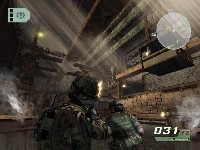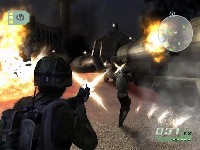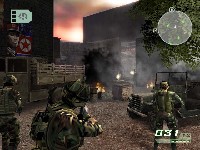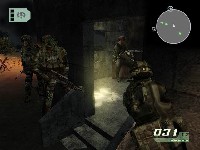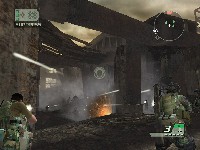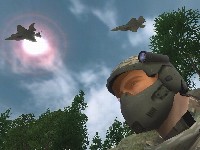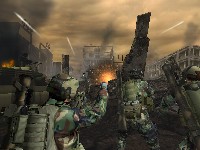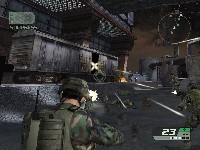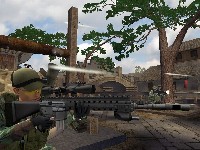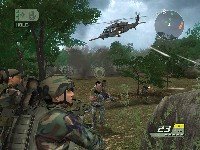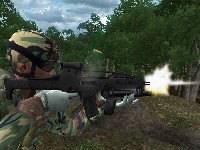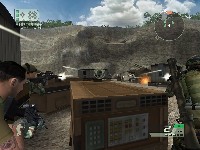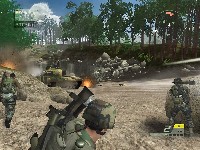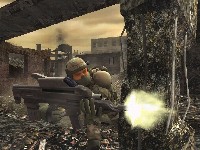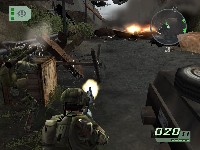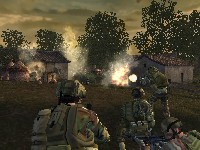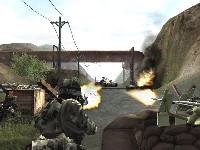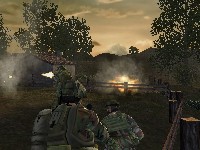Xbox | GameCube | PC | PlayStation 2
Ubisoft’s current control over the entire Tom Clancy branded line has produced some mixed results. Fans of the original PC version of Rainbow Six are clearly getting the short end of the stick thanks to the developer; their love for the extreme realism and complexity of the first two games in the series has been hampered by the simplified console-focused approach of Ubisoft’s sequels. Console fans, on the other hand, are receiving a fantastic vision of the ultra-realistic gameplay that the Clancy line is known for, with the Xbox receiving one of the best uses of Microsoft’s Xbox Live service in the form of Rainbow Six 3. Along with the revered Splinter Cell series, the Ghost Recon games are a brand developed completely under the guiding hand of Ubisoft. Splinter Cell is a console game through and through; Ghost Recon is Rainbow Six with an outdoor angle on the action.
The first Ghost Recon was meant to be a brainy affair, just as the Rainbow Six games were before it. It felt almost more like a Rainbow Six 2.5 than a new series altogether; sort of a way for Ubisoft to test the waters before releasing the real deal. Its gameplay was extremely tight, especially in multiplayer modes and when played through Live, but it carried a few flaws with it. Enemy locations could be memorized, ruining the appeal of true-to-life events occurring. When not playing a Terrorist Hunt game with the enemies placed in random locations, the stages could be memorized using the same mentality that would be applied to a game of Contra -- I.E., not very realistic, which diminishes the entire point of the game. So with Ghost Recon many of us stuck to our multiplayer terrorist hunts, and sat on the edge of our seats, having a fear-driven blast navigating through the badly rendered terrain, our eyes being damaged by the sharp aliasing at every edge. The game’s follow-up, Ghost Recon: Island Thunder, brought more of the same. Meaning, more fun, along with more pointless flaws. A full sequel was badly needed.
And now it is here. Ghost Recon 2 for Playstation 2 is actually one of two new games bearing the same title. The PS2 edition takes place in the year 2007, the beginning of the story. The Xbox version wraps up the narrative, with its genesis marked at the year 2011. Both games are mostly similar, yet shipped with a few startling differences that, in some cases, may make or break whether or not one version or the other is worth buying.
Ubisoft chose to take a different route with their new Ghost Recon than many may have expected. In the wake of the massively popular SOCOM 2, the developer molded their game to be closer to what fans expect from that series instead of one of their own. The first major change is the focus on a third-person view. While the original Tom Clancy game, Rainbow Six, was noted and, by fans, lauded for not including a gun avatar on-screen (it would block part of the field of vision), Ghost Recon completely throws that developmental ideal away. The placement of your solider on-screen not only blocks view, it also changes the way the game is played, since every movement accounts for the position of your solider. While it becomes intuitive to deal with soon enough, this change will not be welcome to most Ghost Recon fans, although that massive SOCOM crowd may gladly take to it.
Ghost Recon 2’s single player missions are not exactly the meat of the game, though they are an important draw for those of us who plan on playing the game offline-only – the Playstation 2 version has no offline multiplayer component to speak of. Sadly, for those of us not blessed by the advent of broadband internet access, Ghost Recon 2’s single player feels much weaker than what was in the original game. Team members spew out silly “bad-assed” quips throughout the game. Enemies once again have static placements, once again ruining any level of realism that could have been present. Each mission has simple mission guidelines, usually along the lines of, “attack this and survive” or “defend this and make sure it survives”.
The main problem with the single player experience is that it feels completely lazily thrown together. Strict mission plans beyond learning the locations of each enemy are all that is really needed in this game. For a series with a brand name behind it that boasts realism, the gameplay is so cookie cutter in such a badly designed way that it feels as though the developers put no thought behind this release. If I want to memorize layouts, I’ll play Metal Slug. If I want a realistic, on-your-toes strategic experience, shouldn’t I play a Tom Clancy game? Ghost Recon should be carving its own niche to attract gamers to it. If a SOCOM fan wants to play SOCOM, he needs only to grab the game off his shelf and insert it into his console; going out and buying another version of the game would be a waste of time and money.
Terrorist Hunts in single player mode do prove to be a blast, yet none of the levels have strong enough layouts to truly take advantage of the wide-open locales. The stages in the first Ghost Recon actually prove superior in design, as they were often more open to changing styles of combat. The sequel seems to stick with its SOCOM-inspired design philosophy, and puts a focus on close combat that completely ruins the point of outdoor gameplay.
Multiplayer, as always, is the best reason to play Ghost Recon 2. Nothing is as exhilarating as barking commands out at your team of real-life squadmates. While the same flaws from the single player mode are still present, the new layer of gameplay brought about by communication takes the attention away, at least somewhat. However, the game still suffers from the absence of an offline multiplayer mode. Most of my time on the first Ghost Recon was spent running, ducking, and gunning with a friend. While the game wasn’t perfect by any means, it still managed to hold our attention through the wee hours of the night. Sitting next to a friend, devising strategies, shouting out warnings and advice/commands… it was fantastic. Without that, I think Ghost Recon 2 is skipping out on an important audience.
Perhaps the lack of offline multiplayer was due to the upgraded graphics. While that may be true, it would only point to the incompetence of the game’s engine; though it is a massive improvement over the first game, it still doesn’t look half as good as it should in the year 2004, even on the restricting Playstation 2 hardware. No graphical glitches are anywhere to be found outside of a smidgen of slowdown, but the art is completely uninspired. It’s not that the artists didn’t take any artistic license that’s my problem; it’s that a game meant to be so realistic looks so completely ugly and unrealistic. Bare, bland textures blanket jagged, blocky geometry. And there isn’t much more to be said besides that, because that’s all there is to see.
Ghost Recon 2 is amazingly impressive in the sound department, however. Music is sparse, although when it does appear it is overly melodramatic, especially in cutscenes. But in the actual game, sound is so realistic, you can almost see the bullets wizzing by – well, actually, you can, if you look at your screen, but they won’t actually look very realistic.
Ghost Recon 2 is less a step up than it is a reimagining of the entire series, ignoring everything that made up the first game. Instead of making improvements, the development team made a game to appeal to a different crowd than their original audience, and I honestly don’t think the decision was a good one. No offline multiplayer, only incremental graphical improvements, and the cumbersome third-person view make Ghost Recon 2 a release that is much less than what it was expected to be – no, what it should have been.
Score: 6.0/10
More articles about Ghost Recon 2











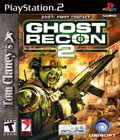 Ghost Recon 2 is set in the chaotic battlefields of tomorrow, and will offer gamers an insider's view of the way large scale conflicts will be fought in the near future.
Ghost Recon 2 is set in the chaotic battlefields of tomorrow, and will offer gamers an insider's view of the way large scale conflicts will be fought in the near future.